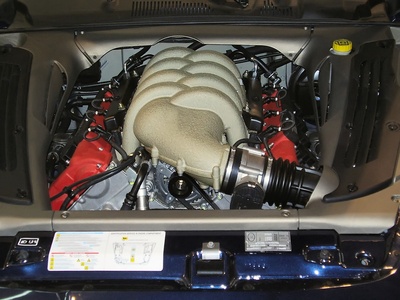
Complex computer controls make modern auto engines practically sentient in their ability to recognize external and internal stimuli and adapt to accommodate them. The engine's sensors are its eyes and ears; if any one of them were to fail, the engine would have to "fly blind" and fall back on preprogrammed parameters. Furthermore, modern engineering allows the auto engine to interface with chassis and transmission controllers to offer the best performance for any conditions.
An engine needs three basic things to function: a correct ratio of air to fuel, a well-timed spark to ignite it, and self-diagnostics to ensure that oil flows and the temperature remains stable. Every single sensor on the engine itself is there solely to provide the computer with real-time information on airflow, air/fuel ratio and crankshaft/camshaft position so that it can adjust fuel injection and spark timing.
Mass airflow (MAF) systems use a heated sensor in the engine's intake duct to calculate the amount of air going in, a throttle position sensor to determine how far the gas pedal is depressed, and one or more oxygen sensors to decide whether or not the engine is getting the right amount of fuel for the air ingested. A crankshaft/camshaft position sensor tells the computer where the pistons are in their stroke, which determines fuel injection and spark timing.
Manifold air pressure (MAP) systems work on a slightly different principle. MAP systems don't measure airflow directly; they use an intake-manifold mounted pressure sensor and air temperature sensor to determine air density and engine demand. The computer uses this information to extrapolate for the amount of air and fuel the engine should need for a given RPM. MAP systems work well for unmodified engines, but (because they are preprogrammed with the engine's parameters) are often incompatible with aftermarket modifications like larger camshafts, turbochargers and superchargers.
There are two basic types of crankshaft/camshaft position sensors, magnetic and Hall Effect. Magnetic sensors work on the principle that metal passing in front of a magnetic field causes changes in the magnet field. The engine uses a gear-like wheel passing in front of the magnet to cause variations in the field, which tells the engine how fast the engine rotates. Hall Effect sensors work on a related principle, but sense current reversions caused by the passing gear-wheel.
Oxygen sensors represent a science in and of themselves, and rely on a fascinating electrochemical phenomena wherein certain crystals (like cubic zirconia) actually produce an electrical current when heated. Exhaust gas temperature rises linearly with fuel-to-air ratio; thus, oxygen sensors can indirectly determine air/fuel ratio by reading exhaust heat. High temperatures mean too much fuel, low temperatures mean too little. Fun fact: oxygen sensors are the only sensors in you car that produce their own voltage.